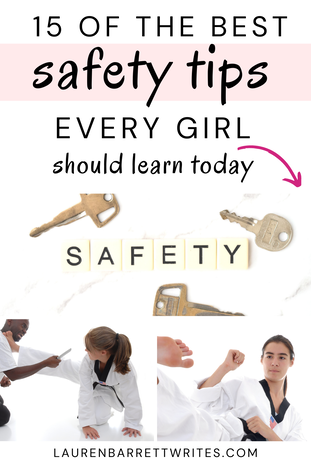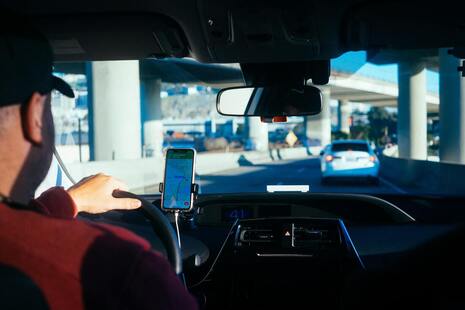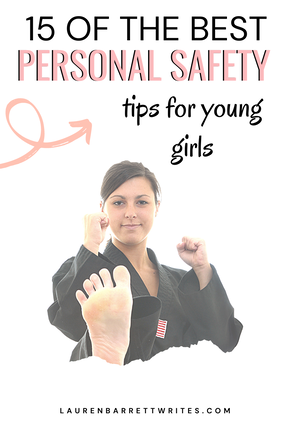|
The statistics are not great. 1 in 5 women experience completed or attempted rape. 81% of women and 43% of men experience some form of sexual harassment in their lifetime. And that is what is reported. With that information, self-defense should be a required teaching component in all high schools throughout America, but sadly it is not. While I am not an expert and neither am I trained in self-defense, I gathered some of the best self-defense/safety tips that I have learned over the years and researched myself and brought them to a group of students in my freshmen Homeroom class. They were captivated and engaged throughout the whole 30 minute lesson. Phones barely came out. While I am aware that every school can’t hire a licensed professional to teach a course on self-defense (though they should), these 15 tips can be life-saving, and teenagers, especially young girls need to learn these personal safety tips today. Rideshare Safety 1. Always ask the driver who he/she is here for. Before you even enter a rideshare, such as an Uber or Lyft, always ask the driver who he/she is here for instead of asking, “Are you here for (your name)?” Why? To minimize the chance of getting in the wrong car, especially at busy areas where a lot of rideshares are driving around picking up people, you want the driver to have to look at his phone to double check who he/she is here for. If you just say, “Are you here for (your name)?” the driver can merely say, “yes,” without confirming. Unfortunately, there have been reported incidents of fake Uber or Lyft drivers preying on innocent people. These drivers pose as a rideshare service but are only doing it to scam you of money or worse. That is why you always need to (1) confirm the make and model of the car from the app with the car that shows up in person, (2) Ask them who they are picking up, and (3) Ask them for their name. 2. Screenshot the driver’s information and share with a loved one. Before or once the driver has picked you up, share the details of your trip with someone you love right away. Send them the make and model of the car, the name of your driver, where they picked you up, where you are going, and how long the ride should last. Once you have safely reached your destination, reach out to your loved one to confirm that you arrived. At the start of the trip, you should have established with your loved one that if you don’t text to confirm you have made it within x number of minutes, your loved one should attempt to get in touch with you. If they cannot, instruct them to call the police. This tip is especially important if you are riding alone. 3. Use your home address with caution. Should you use your home address or not when getting in a rideshare? I’ve seen this debated on online forums before. While I always use my home address now, I also live with my husband with a home security system. After high school, these teenagers might live alone or in an all-female house. To protect the safety of its customers, Uber makes it easy to enter a street nearby without having to enter your exact home address. I advised my students to follow this safety procedure especially if they live alone or with only females. 4. Sit in the back seat. Uber lists this as a safety tip on their website, and I agree. Not only does it give you some personal space from the driver, but you can also choose which way to exit if having to be dropped off on a busy street. Even still, if faced with a dangerous situation, such as an erratic or threatening driver, they have less access to grabbing you or stopping you from escaping if you sit in the backseat. With more and more people using rideshares, especially teenagers who cannot drive yet, these safety tips for rideshare need to be taught at an early age. Everyday Routines 5. Shift Your Awareness. Survivor and founder of a program called Kids S.A.F.E, a self-defense class, Robyn Warner shares that there are different levels of awareness. Most of the time we spend our life in neutral, but Robyn says there are times when we need to upshift our awareness, especially for women, in situations that leave us more vulnerable: at the ATM, pumping gas at night, taking the garbage out at dusk, and going on runs. She then advises us to go back to neutral, so we don’t live our lives paranoid. That means we need to rethink our everyday routines and change some things about them in order for us to be prepared and safe. I cautioned my students to not do the same thing at the same time every day, especially if they were doing that thing alone. That could look like not always running on the same trail at the same time every day to avoid potential stalkers knowing your routine. It’s also important to share your location if you plan on running alone and how long you expect to be gone. 6. Carry an emergency kit. When going out, have an emergency kit readily available to tuck into your purse or pocket. That includes all or one of the following: mace, pepper spray, pocket knife, flashlight, or rape whistle. That way if you are ever attacked, you are prepared. Practice carrying these things around and taking them wherever you go. Get into the habit of remembering these things. Do not just brush it off if you forget them. “Oh, I won’t need it.” No, go back and get it until it becomes second nature. 7. Ask for an escort. If you feel unsafe walking back to your car from the mall or back to your apartment from a party, don’t feel embarrassed to ask for an escort. The escort could be as simple as insisting a friend walk back with you or asking security to walk you out. And if you are in a situation where neither of those options are available, call the cops or 911. Trust your instincts. It’s always better to be safe, not sorry. 8. Lock the doors as soon as you get in the car. Oftentimes when we get into the car, we get distracted by looking at our phone, pulling up GPS or finding a podcast that our level of awareness goes way down. I cautioned my students to get into their cars and immediately lock the doors before doing anything else. That way if they need to be idle before pulling away, someone can’t easily enter their car without casting suspicion first. I warned that this is especially important when they are traveling alone, it’s nighttime, and they are in a deserted area. 9. Check under the car and in the backseat. I told my students to check under the car and the backseat at night. That’s why it would be beneficial to carry a flashlight in order to do a quick scan to make sure no one is there or anything is remiss (i.e. flat tire). 10. Use caution with suspicious people. When you are alone, especially when it’s dark outside, be wary of suspicious people hanging around your car or your path home. This is when Robyn says to really upshift your awareness and be on high alert. She says this is the time when you do not want to present yourself as an easy opportunity, meaning don’t be looking down at your phone or slumping your shoulders. Walk with your shoulders back and look people in the eyes. It also helps to talk directly to the suspicious person “You are making me uncomfortable,” or about the suspicious person on the phone, “There’s this guy hanging out by my car. He has on blue jeans and a white shirt. He’s about 6’2 with brown hair and a beard.” I also told my students about a time I took a self-defense course, and the instructor told us to act crazy. She said to talk to yourself in different voices and mumble nonsense. I told my students to practice this, so if/when the moment arises, they are prepared. The instructor told us that an attacker wants a vulnerable, easy victim, not an erratic, unstable person. In an attack 11. Yell out information. While teaching her courses, Robyn always asks her participants what they would do in the event of an attack. She says all of them usually say that they would scream or make some noise. While Robyn says that is good, she preaches that we need to yell out actual information. “Lauren Barrett, and I am getting attacked by a man. He is trying to assault me. Walnut Creek Greenway.” Repeat over and over. People scream. Kids can scream when they play. A parent can scream at her children. So the likelihood of a scream going ignored is higher than if we yell out information of what is happening to us. Robyn says that this isn’t always easy in the moment, so we need to start practicing, especially at an early age. 12. Try to get your phone to dial 911. In addition to yelling, call out to your phone to dial 911 (“Hey Siri, dial 911.”). And yell the same information about the location of your attack, what your attacker looks like, and what is happening over and over in the hopes that 911 picks it up. When Robyn was attacked, she had dialed 911 right before her attacker got to her because she was already highly suspicious of the man. And that is likely one of the reasons she survived. 13. Stay at the scene. When being attacked, it’s best to try to stay at the scene of the attack or as near as possible. You don’t want your attacker to take you someplace else, especially since you yelled out your location over and over. Someone could have heard you and is sending help or you were able to dial 911. 14. Scream in the attacker's face and talk to the attacker. Another thing that I learned in the self-defense class I took is that when your attacker grabs you, instead of trying to turn and pull away, which only strengthens his grip on you, you want to lean in, do a self-defense move, and scream in his face (think Mufasa’s roar in the Lion King instead of a little kid’s terrified shriek). Then, Robyn says to talk to your attacker. “What’s your name?” “Where do you live?” “Why are you doing this?” Robyn says this makes you feel more human in your attacker’s eyes. She said that when she did this with her attacker, he would stop and pause, and in that time, she was able to take a breather and readjust her clothes. 15. Learn self-defense moves. I recommended to the students in my class to take a self-defense class to learn the proper moves for escaping or fighting back against an attacker. I really think all teenagers should learn in high school if not earlier and continue to refresh their skills every few years. In her class, Robyn teaches to go for the breeder or the breather. That is the face (eyes, nose, mouth, esophagus) and the groin. People can work out their arm and leg areas to make them stronger and no match for you, but everyone’s eyes, nose, mouth, esophagus, and groin are on the same playing field. She warns that you have to fight back and those are the critical areas to target to incapacitate your perpetrator. The bell rang for the day of our session, and I could tell my students wanted to learn more. Some even questioned why this wasn’t taught in health/PE. Even if it isn’t officially a required course, these 15 tips can be reviewed by parents and teachers in the hopes of preventing an attack or saving a life one day. As Robyn’s motto goes, “prepared not scared,” we want our young adults to grow up with the knowledge that they are capable of fighting back against the evil of this world and the independence to take care of themselves. You can follow her on Instagram @aflyonmywall for more weekly advice on all things self-defense and safety.
0 Comments
Leave a Reply. |
Categories
All
|
Proudly powered by Weebly








 RSS Feed
RSS Feed